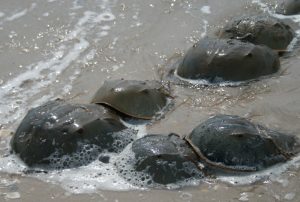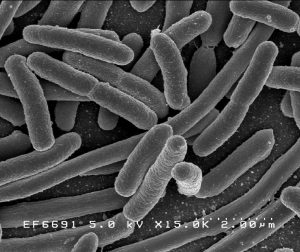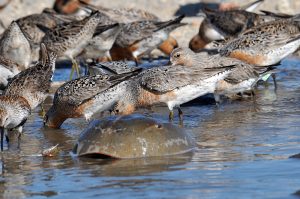Maloney, T, Phelan, R. and Simmons, N., “Saving the horseshoe crab: A synthetic alternative to horseshoe crab blood for endotoxin detection” (2018), PLoS Biol 16(10), https://doi.org/10.1371/journal.pbio.2006607
The first time I ever saw a horseshoe crab, I shrieked, speeding away from the water terrified that the dark spiny “stingray” behind me had nothing in its mind but to poke its swinging, stiff tail into my foot. Much to my surprise, when my dad came to look at the innocent horseshoe crab, he laughed, assuring me it couldn’t hurt me. More closely related to a spider than a crab, Limulus polyphemus is a local in New England waters that has been around for over 450 million years. It does not sting, can barely pinch, and in fact has saved countless human lives. The horseshoe crab’s blue blood can be used to test for dangerous endotoxins in medicine. Yet the combination of increased stress from climate change as well as continued harvesting may be taking its toll on horseshoe crabs, which have been declining on the east coast of the US. In order to spare the horseshoe crab, we need to reconsider how we save human lives, without endangering vulnerable horseshoe crab populations. Researchers from Revive and Restore, a non-profit organization whose mission is to protect endangered species, went out to explain why we continue to use horseshoe crab blood when a safe and viable alternative has already been discovered, and to propose how we can fix this problem before it’s too late.

What is so special about horseshoe crab blood? The blood is the primary component of the Limulus amebocyte lystate test, or LAL test for short. The test can detect endotoxins, a type of contaminant that exists on the exterior of gram-negative bacteria like E. coli. When the blood of a horseshoe crab encounters an endotoxin, a molecular game of telephone ensues. A molecule called factor C communicates to another molecule called factor B that there are endotoxins present, and factor B then communicates with clotting enzymes, causing the blood to clot and show the presence of endotoxins. This test is so important that the FDA requires every drug it approves, as well as all injectable medicines and medical devices to be tested this way.

About 500,000 horseshoe crabs are captured for their blood on the east coast of the US every year. During capture, up to one third of the animal’s blood can be drained. After this, about 13% of the captured animals are sold to be used as bait; the rest are released to the wild, where it is estimated that about 15% to 30% die. In total, this suggests that about 130,000 horseshoe crabs die from this process every year, and that does not take into account the possible side effects and repercussions for the animals that do survive the procedure.
It doesn’t have to be this way, however. Scientists at the National University of Singapore discovered that a cloned version of factor C, the first important molecule in the LAL test, can be used to test for endotoxins. The resulting tests that have been developed from this discovery are called recombinant Factor C, or rFC for short. Unlike the LAL test, there is no molecular game of telephone, only factor C, which activates a fluorescent compound when it comes in contact with an endotoxin. In short, it glows, and the more the sample glows after rFC, the more contaminated it is.
In some ways, the rFC test is even better than the LAL test. It isn’t susceptible to all the false positives that plague the LAL test, and it appears better equipped to avoid false negatives as well. Across studies comparing rFC to LAL, the researchers found that rFC was at least as good, if not better than LAL.
This option has been available since 2003, so why hasn’t the biomedical industry switched yet? Part of the reason is that endotoxins can be quite dangerous; the companies know they have a system that works, and they don’t want to risk altering their protocols. Another hurdle is getting different governing bodies to acknowledge rFC as a reliable way to test for endotoxins, which can result in a lot of paperwork and legal headaches before it is fully enacted.
One way that companies could start making the switch immediately, however, would be to start testing water and manufacturing materials used for medical products with rFC instead of LAL. By doing this, the researchers estimated that 90% of the demand for LAL in pharmaceutical manufacturing could be cut. With more and more companies able to supply rFC, this is becoming a more economically feasible option.

By switching medical manufacturing procedure to use rFC, as many as 100,000 horseshoe crabs could be saved in North America every year. This can be an important leg up for a species already under the stress of adapting to climate change. Now is the time. The IUCN changed the status of the mid-Atlantic horseshoe crab populations from “near threatened” to “vulnerable” in 2016. Decreasing horseshoe crabs aren’t just bad for one species, but for many; a number of shore birds, most notably the red knot, rely on horseshoe crab eggs for food. Due to declining horseshoe crab numbers, the red knot was classified as threatened under the US Endangered Species Act in 2014.
With a feasible, safe, and affordable alternative at our fingertips, what are we waiting for? It is time to approach this ethically, economically, and ecologically. By making the switch, we improve the chances that horseshoe crabs will be able to adjust to the changing world around them.
I am a PhD student studying Biological Oceanography at the University of Rhode Island Graduate School of Oceanography. My interests are in food webs, ecology, and the interaction of humans and the ocean, whether that is in the form of fishing, pollution, climate change, or simply how we view the ocean. I am currently researching the decline of cancer crabs and lobsters in the Narragansett Bay.


My question is, how can I work in horseshoe crab fishing? What is the salary? and how many working hours? How do I contact the medical laboratory so that they can receive these crabs from me? And if my job in the laboratory is the same as taking a blood sample from a horseshoe crab? What do you want from me, such as a certificate or license, what do I do?